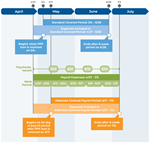Earlier this year, in March 2020, Congress passed the Coronavirus Aid, Relief, and Economic Security (CARES) Act, which provided funding for individuals, businesses, healthcare entities, and state and local governments to help them meet short-term cashflow needs. One provision of the CARES Act was the Paycheck Protection Program (PPP), which authorized a total of $649 billion in potentially forgivable loans guaranteed by the Small Business Administration, allowing small business owners to maintain their employees and mitigate pay cuts.
For a PPP loan to be forgiven, funds received must be spent on a pre-defined set of qualifying expenses. At least 60% of the amount of a PPP loan that is forgiven must have been used for payroll expenses (which, subject to certain limitations that apply to business owners, include not only salary and wages, but also vacation, family, and medical leave; group health coverage; retirement benefits; and state and local taxes), and the remaining funds (no more than 40%) on rent, mortgage interest, utilities, and business interest on debt incurred before February 15, 2020.
Some forgiveness limitations apply to payroll expenses for business owners themselves and can affect the amount of group health coverage, retirement benefits, and/or state and local taxes paid that are attributable to their own employment. Furthermore, the forgivable amount of the loan only applies to those expenses either paid or incurred during the “Covered Period” of the loan.
If the loan was funded on or after June 5, 2020, the Covered Period is 24 weeks, beginning on the date that the loan is funded. For loans funded before June 5, 2020, the borrower has the discretion to choose a Covered Period of either 24 or 8 weeks long. Business owners who run payroll on a bi-weekly (or more frequent) basis have the option of using the “Alternative Payroll Covered Period”, beginning on the first day of the payroll period that begins after PPP funding is received (instead of the date when PPP funds are received), which may allow for more payroll expenses to qualify for PPP loan forgiveness.
PPP loans were intended to help business owners keep their employees and mitigate pay cuts in times of financial hardship; thus, the amount eligible to be forgiven for certain loans (i.e., those above $50,000) can be diminished if the employer’s Full-Time Equivalent (FTE) employee headcount is reduced by any amount, or if compensation of non-highly-compensated employees (i.e., those with annual salaries of less than $100,000) is reduced by more than 25% (though Congress provided some flexibility through exceptions for borrowers who made efforts to rehire employees or restore wages).
To determine whether a change in FTE employee headcount will impact the eligible PPP loan forgiveness amount, employers must compare the average weekly FTEs during their Covered Period to the average weekly FTEs during the period between either February 15 – June 30, 2019, or January 1 – February 29, 2020 (employers may choose the period with the lower FTE count), where one FTE is equivalent to a 40-hour work-week, regardless of the individual(s) contributing to those hours (though a single worker cannot comprise more than 1 FTE per week if they work for more than 40 hours during that week). A drop in FTE will have a proportionate drop in PPP loan forgiveness; for instance, a 20% drop in FTE will result in a 20% reduction in eligible loan forgiveness. Alternatively, a ‘safe harbor’ FTE calculation can be used by employers if it provides a more favorable result; the safe harbor method counts employees working 40 hours or more per week as 1 FTE, and employees who work less than 40 hours per week as 0.5 FTEs. Meanwhile, cuts of more than 25% to the compensation of workers with (previous) salaries of less than $100,000 will result in a dollar-for-dollar reduction in the forgivable amount of a PPP loan (to the extent the cuts exceeds the 25% threshold).
Ultimately, the key point is that advisors have various considerations to help their small business owner clients with PPP loans maximize the amount eligible for forgiveness. Specifically, choosing a particular Covered Period that the borrower may be eligible for can have a significant impact on the composition of expenses to be considered for forgiveness. The method to calculate FTEs, the FTE comparison period used to determine whether a drop in FTEs has occurred, and changes in (non-highly-compensated) employee wages can also impact whether the eligible forgiveness amount will be reduced. And advisors should be sure to prepare clients who do receive forgiveness of their PPP loans by reviewing the potential tax liability associated with any amounts forgiven!












